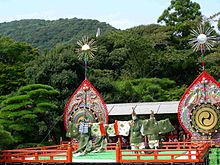| This article needs additional citations for verification. Please help improve this article by adding citations to reliable sources. Unsourced material may be challenged and removed. Find sources: "Kannamesai Festival" – news · newspapers · books · scholar · JSTOR (November 2023) (Learn how and when to remove this message) |

| Ceremonies of the Imperial Palace |
| Shihohai [ja]・Saitan-sai [ja] |
| Genshi-sai [ja] |
| Sōji Hajime [ja] |
| Emperor Showa Festival |
| Emperor Kōmei Festival |
| Kinen-sai |
| The Emperor's Birthday |
| Spring Kōreisai・Spring Shinden-sai [ja] |
| Emperor Jimmu Festival [ja]・Kōrei-den Kagura |
| Empress Kōjun festival |
| Yoori [ja]・Ōharae-shiki |
| Emperor Meiji Festival |
| Autumn Kōreisai・Autumn Shinden-sai [ja] |
| Kannamesai Festival |
| Niiname-no-Matsuri |
| Kashiko Dokoro Mikagura [ja] |
| Emperor Taishō Festival |
| Yoori [ja]・Ōharae-shiki |
Kannamesai Festival, sometimes called Ōmatsuri is one of the most important festivals of Ise Jingu. Held October 15-17 each year, this ritual makes offerings of the first harvest of crops for the season to Amaterasu. An imperial envoy carries the offering of rice harvested by the Emperor himself to Ise, as well as five-coloured silk cloths and other materials, called heihaku (幣帛).
The festival is the culmination of a cycle of festivals that take place throughout the year, beginning in April with the Shinden Geshusai (神田下種祭) which sees the sowing of the rice seeds. This is followed by Otaue Hajime (御田植初) where seedlings are transplanted in May, harvest at the Nuibosai (抜穂祭) in September, and finally, the Kannamesai.
Overview
Kannamesai is one of the three seasonal festivals held throughout year.
The festival is held before the Niinamesai at the Imperial Palace and follows the lunar calendar, taking place in the ninth lunar month and includes an imperial envoy carrying offerings of silk and other gifts.
Rituals and Ceremonies
The festival begins on the evening of October 15 with the Okitama-no-kami-sai (興玉神祭) in which a guardian kami of the shrine, Okitama, is invoked. This is followed by the Miura (御卜), a divination ritual to determine if any of the clergy participating in the festival are impure, rendering them unfit to participate. The clergy then present Error: {{nihongo}}: transliteration text not Latin script (pos 9: о) (help) (由貴大御饌), edible offerings in the form of fish, vegetables, water, and sake, followed by the presenting of heihaku offerings by an imperial envoy, and the rituals are completed with a kagura dance. These rituals are largely repeated twice for each of the Inner and Outer Shrines, once in the evening and once the following morning.
During the festival, the Emperor performs distance worship (御遙拝, Error: {{nihongo}}: transliteration text not Latin script (pos 4: о) (help)) at the Shinkaden (神嘉殿), a hall in the Imperial Palace.
History
The festival may have its roots in the legend from Emperor Suinin's time in which Princess Yamatohime-no-mikoto looked for a place to enshrine the Imperial Family's ancestral spirits during which she made an offering of rice stalks in the beak of a white-naped crane.
This became a true festival in 721 when Empress Genshō sent offerings called reihei (例幣) to Ise Shrine in the ninth month of the lunar calendar. The practice stopped in the Middle Ages but restarted during the Edo period. After Japan adopted the Gregorian calendar in 1873, the ninth month no longer aligned with the harvest season of rice, and the Kannamesai was moved to October in 1879 to compensate.
Notes
- ^ This is an example name. There are three such festivals per year that celebrate the three most recent former emperors after the most recent former emperor.
- This is an example name. The name changes as it celebrates the mother of the previous emperor.
References
- ^ Nakanishi, Masayuki. "Kannamesai (Grand Shrines of Ise)". Kokugakuin University Encyclopedia of Shinto.
- ^ "Isejingu". Archived from the original on 2012-08-03. Retrieved 2007-10-10. – Annual Cycle of Ceremonies and Rice, Official Ise Jingu homepage.
- ^ Nakanishi, Masayuki. "Kannamesai". Kokugakuin University Encyclopedia of Shinto.
- Ellwood, Robert S. (1968). "Harvest and Renewal at the Grand Shrine of Ise". Numen. 15 (3): 165–190. doi:10.2307/3269575. ISSN 0029-5973. JSTOR 3269575.
- "神嘗祭|年間行事|祭典と催し|伊勢神宮" [Ise Shrine Festivals and Rituals: Kannnamesai]. 伊勢神宮 (in Japanese). Retrieved 2024-09-23.
- "神嘗祭" [Updated World Encyclopedia: Kannamesai]. 改訂新版 世界大百科事典. 平凡社. 2014.